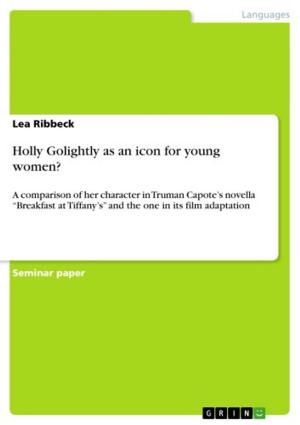The opposing worlds of 'Romeo and Juliet'
Fiction & Literature, Literary Theory & Criticism, British| Author: | Ines Hermeling | ISBN: | 9783640593507 |
| Publisher: | GRIN Publishing | Publication: | April 15, 2010 |
| Imprint: | GRIN Publishing | Language: | English |
| Author: | Ines Hermeling |
| ISBN: | 9783640593507 |
| Publisher: | GRIN Publishing |
| Publication: | April 15, 2010 |
| Imprint: | GRIN Publishing |
| Language: | English |
Seminar paper from the year 2008 in the subject English - Literature, Works, grade: 2,3, University of Münster (Englisches Seminar), course: Hauptseminar, language: English, abstract: 'Shakespeare´s tragischem Liebespaar Romeo und Juliet gelingt es [...] in einer durch Instabilität und Gewalt geprägten Gesellschaft, sich eine von hingebungsvoller Leidenschaft erfüllte private Welt zu schaffen' (Baumann 1998: 94). Uwe Baumann here distinguishes between two worlds in Shakespeare´s tragedy 'Romeo and Juliet': on the one hand the lovers´ world, characterised by passion and intimacy; on the other hand the real world, full of violence, chaos and hatred. However, these two opposing worlds cannot be regarded separately. The preposition 'in' already implies that Romeo and Juliet are dependent from their surrounding society and during the short period of their love affair it is inevitable for them to act within its rules and regulations. This academic assignment deals with the question how the lovers create their own world and how this private world relates to the real world of Verona. Scholars have often pointed out that Romeo and Juliet differ from their environment concerning their special use of language. It can be described as 'magical, passionate, transformative language' (Greenblatt e.a. 1997: 868) enriched with similes, symbols and metaphors. One dominating image, frequently used by the lovers to describe each other and the phenomenon of their passionate love, is light. The first chapter therefore mainly deals with the linguistic presentation of light images in Romeo and Juliet. In addition, the special function of night and darkness for the lovers shall be examined. The light theme is heavily connected to the aspect of time. Thus, chapter two will examine how the lovers deal with the problem of (limited) time during their secret meetings. An interesting key scene for the examination of both, light/darkness and time, provides the final farewell of the lovers (3.5), which therefore will be discussed in detail. Finally, the lovers´ world shall be examined in terms of its connections to the real world of Verona. The problem of Romeo´s and Juliet´s increasing isolation and loss of their counsellors will be of special interest here.
Seminar paper from the year 2008 in the subject English - Literature, Works, grade: 2,3, University of Münster (Englisches Seminar), course: Hauptseminar, language: English, abstract: 'Shakespeare´s tragischem Liebespaar Romeo und Juliet gelingt es [...] in einer durch Instabilität und Gewalt geprägten Gesellschaft, sich eine von hingebungsvoller Leidenschaft erfüllte private Welt zu schaffen' (Baumann 1998: 94). Uwe Baumann here distinguishes between two worlds in Shakespeare´s tragedy 'Romeo and Juliet': on the one hand the lovers´ world, characterised by passion and intimacy; on the other hand the real world, full of violence, chaos and hatred. However, these two opposing worlds cannot be regarded separately. The preposition 'in' already implies that Romeo and Juliet are dependent from their surrounding society and during the short period of their love affair it is inevitable for them to act within its rules and regulations. This academic assignment deals with the question how the lovers create their own world and how this private world relates to the real world of Verona. Scholars have often pointed out that Romeo and Juliet differ from their environment concerning their special use of language. It can be described as 'magical, passionate, transformative language' (Greenblatt e.a. 1997: 868) enriched with similes, symbols and metaphors. One dominating image, frequently used by the lovers to describe each other and the phenomenon of their passionate love, is light. The first chapter therefore mainly deals with the linguistic presentation of light images in Romeo and Juliet. In addition, the special function of night and darkness for the lovers shall be examined. The light theme is heavily connected to the aspect of time. Thus, chapter two will examine how the lovers deal with the problem of (limited) time during their secret meetings. An interesting key scene for the examination of both, light/darkness and time, provides the final farewell of the lovers (3.5), which therefore will be discussed in detail. Finally, the lovers´ world shall be examined in terms of its connections to the real world of Verona. The problem of Romeo´s and Juliet´s increasing isolation and loss of their counsellors will be of special interest here.















